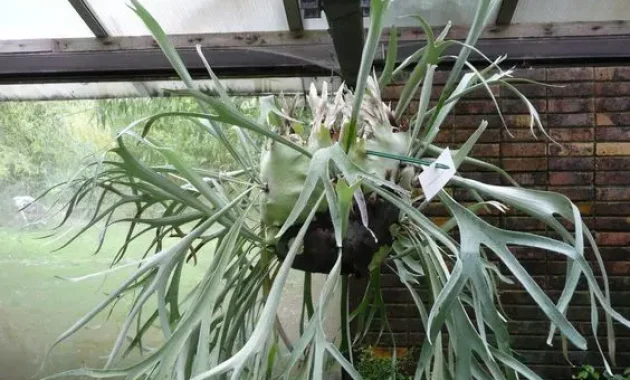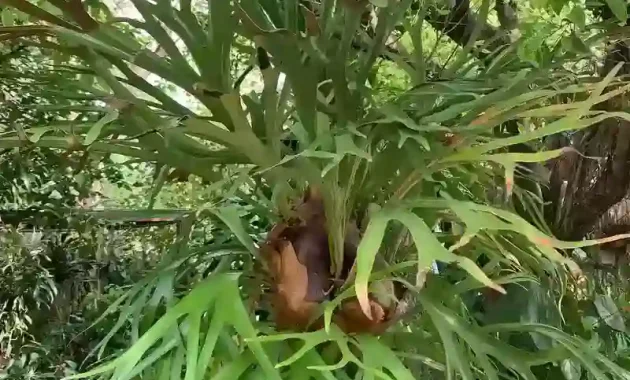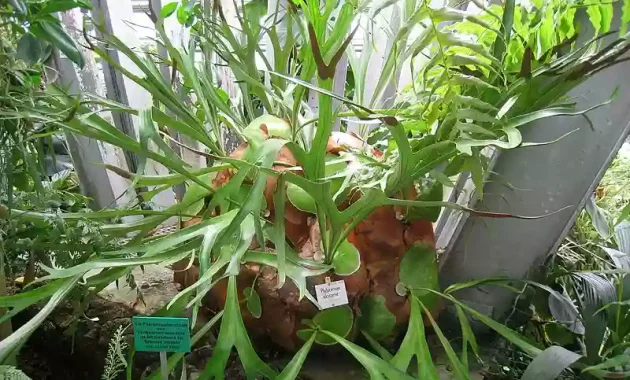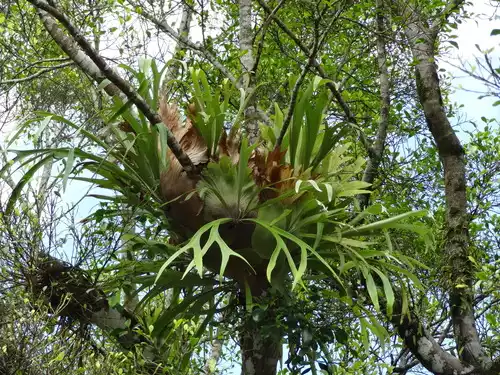The Platycerium alcicorne, commonly known as the staghorn fern, is native to various regions including Madagascar, the Seychelles, Comoros Islands, Mozambique, and Zimbabwe. This intriguing plant species has captured the attention of plant enthusiasts due to its distinctive features and growth behavior. Initially believed to be a separate species from Platycerium vassei, current expert opinion suggests that they are actually the same plant.
One notable characteristic of the Platycerium alcicorne is its shield fronds which resemble those of other related species such as P. ellisii, P. hillii, P. ridleyi, and P. madagascariense. These rounded shield fronds indicate their origin in rainforests with ample water supply. Acting as a protective layer for the rhizome against excessive watering-induced rotting, these shield fronds play an essential role in maintaining the health of this fern.
Appearance and Features of the Platycerium alcicorne
The appearance of Platycerium alcicorne can vary depending on its geographic location. The Madagascan variant displays deep green coloration and a hairy texture while some specimens have fertile fronds that are dark green on top and nearly white underneath. On the other hand, African variants exhibit yellow-green coloration with a waxy texture and minimal hair presence. Both forms follow similar growth cycles with dormancy during winter months and dying off of shield fronds in late summer and fall.

The distinctive features of Platycerium alcicorne make it a visually captivating plant species. One notable characteristic is its shield fronds, which are rounded and act as a protective layer for the fern’s rhizome. These shield fronds prevent rotting caused by excessive watering, indicating the origin of this species in rainforests with abundant water supplies. The Madagascar variant is recognized by its deep green color and hairy texture, while the African form presents a yellow-green color with a waxy texture and fewer hairs.
Another interesting feature of Platycerium alcicorne is its growth cycle. During winter dormancy, the shield fronds die off in late summer and fall. It is important to reduce watering and fertilizing during this period to mimic natural conditions. However, it should be noted that the African variant is less tolerant to excessive watering compared to its Madagascar counterpart.
Overall, Platycerium alcicorne stands out due to its distinct features such as shield fronds and unique growth behavior during dormancy periods. While care requirements must be met for optimal growth, these fascinating ferns offer an intriguing addition to any plant collection regardless of one’s level of expertise in horticulture or love for plants.

Care Requirements for the Platycerium alcicorne
Maintaining the health and beauty of this fascinating plant requires specific care and attention. Whether you choose to keep your Platycerium alcicorne indoors or outdoors, it’s important to understand its care requirements.
When it comes to watering, this fern prefers to be kept moist, but not overly saturated. As a general rule, water it thoroughly once a week during the growing season, and reduce watering in the winter months to avoid waterlogged roots.
It’s crucial to remember that this fern is an epiphyte, meaning it naturally grows on other plants, so it requires good air circulation. If you decide to keep it indoors, place the plant near a window where it can receive bright, indirect light. If you choose to grow it outdoors, make sure it is protected from direct sunlight and strong winds.
Additionally, fertilize the fern once a month during the growing season to provide it with the necessary nutrients. By following these care requirements, you can ensure the longevity and vibrancy of your Platycerium alcicorne.
The Growth and Reproduction of Platycerium Alcicorne
The growth and reproduction of Platycerium alcicorne, also known as the staghorn fern, is a fascinating process that requires specific care and attention. These ferns have a unique life cycle and reproductive strategy that contribute to their overall resilience and survival.
Platycerium alcicorne begins its growth from spores, which are tiny reproductive cells produced by mature fronds. These spores are released into the air and can travel long distances before finding a suitable place to germinate. Once they land on a suitable substrate, such as tree trunks or rocks, they begin to develop into young plants.

As the staghorn fern grows, it forms two types of fronds: shield fronds and fertile fronds. Shield fronds are large, flat structures that grow horizontally and serve as protection for the plant’s rhizome. They also collect water and nutrients from the environment. Fertile fronds, on the other hand, are smaller in size but play a crucial role in reproduction. They bear sporangia – specialized structures that produce spores.
During their reproductive phase, Platycerium alcicorne produces clusters of sporangia on their fertile fronds. These sporangia release spores into the surrounding environment when they mature. The wind carries these spores to new locations where they can potentially germinate and establish new colonies of staghorn ferns.
It is important to note that Platycerium alcicorne has specific requirements for optimal growth and reproduction. It thrives in humid environments with indirect light exposure. Adequate watering is essential but overwatering should be avoided as it can lead to root rot or fungal diseases mentioned earlier like black leaf spot caused by Rhizoctonia fungus.
By understanding these propagation techniques and providing optimal growing conditions, you can effectively reproduce the Platycerium alcicorne and expand your collection of these fascinating ferns.
Placement and Display of the Platycerium alcicorne
When displaying the Platycerium alcicorne, consider placing it in a hanging basket or mounting it on a tree branch to showcase its beautiful cascading fronds. Hanging baskets are a great option because they allow the fern to drape down and create an eye-catching display.
Choose a basket that’s large enough to accommodate the fern’s growth and make sure it has proper drainage to prevent waterlogging. Hang the basket in a spot that receives bright, indirect light, as the Platycerium alcicorne prefers filtered sunlight.
Another popular option for displaying the Platycerium alcicorne is wall-mounted displays. These can be done using a variety of materials such as wood, cork, or even moss. Mounting the fern on a wall can create a stunning vertical garden effect and add a unique touch to any space.
When mounting the fern, make sure to secure it tightly and provide a stable base for it to grow. Consider positioning the display in an area with good air circulation to prevent excessive humidity and ensure the fern’s health.
Whether you choose to go with a hanging basket or a wall-mounted display, the Platycerium alcicorne is sure to be a showstopper in your home or garden. Its distinctive fronds and unique growth habit make it a truly captivating fern to have. So go ahead, get creative with your display and let the Platycerium alcicorne take center stage!
Common Issues and Troubleshooting for the Platycerium alcicorne
If you’re experiencing any issues with your Platycerium alcicorne, troubleshooting common problems can help ensure its health and vitality.
One potential issue that you may encounter with your fern is pests. While the Platycerium alcicorne is generally resistant to pests, it can still be susceptible to certain insects such as mealybugs or scale. To combat these pests, regularly inspect your fern for any signs of infestation, such as small white insects or sticky residue on the fronds. If you do notice any pests, you can try using a mild insecticidal soap or neem oil to eliminate them.
Additionally Rhizoctonia or black leaf spot fungal disease may affect these plants causing black spots on their fronds Overwatering is usually responsible so reducing watering frequency can help address this issue. In severe cases, seeking professional advice for chemical control solutions is recommended.
Another common issue that can affect the health of your Platycerium alcicorne is improper watering. It’s important to find the right balance when it comes to watering frequency for this fern. Overwatering can lead to root rot, while underwatering can cause the fronds to become dry and brittle. To ensure proper watering, wait until the top inch of the soil feels dry before watering again, and make sure the pot has good drainage.
By addressing these common issues and taking proper care of your Platycerium alcicorne, you can help it thrive and enjoy its unique beauty.
Frequently Asked Questions
How long does it take for a Platycerium alcicorne to reach its full size?
To care for a platycerium alcicorne indoors, ensure it receives indirect sunlight and water it regularly. The benefits of having this fern in your home include its unique appearance and ability to purify the air.
Can the Platycerium alcicorne be grown outdoors in colder climates?
Yes, the platycerium alcicorne can survive in colder climates. To protect it from frost, ensure it is planted in a sheltered area, cover it with mulch or straw, and provide additional insulation with a frost cloth.
Is it possible to propagate the Platycerium alcicorne from spores?
Yes, you can propagate Platycerium alcicorne from spores. To do so, you need to create optimal conditions for its growth, such as providing high humidity, diffused light, and a well-draining substrate.
What is the best way to display a Platycerium alcicorne in a hanging basket?
To display your platycerium alcicorne in a hanging basket, follow these tips and tricks. Ensure the ideal conditions for your fern, such as indirect light, high humidity, and a well-draining potting mix.
Are there any common pests that affect the Platycerium alcicorne and how can they be controlled?
Common pests like aphids and mealybugs can harm your platycerium alcicorne. To control them, spray the fern with a mixture of water and mild soap. Regularly inspect your plant and remove any pests you spot. The fern typically takes 2-3 years to reach its full growth.
Conclusion
If you’re looking for a unique and stunning fern to add to your collection, the Platycerium alcicorne is the perfect choice.
With its distinctive antler-like fronds and its ability to grow on both trees and rocks, this fern will certainly make a statement in any space.
While it does require some specific care, such as misting and indirect light, the effort is well worth it for the beauty it brings.
So go ahead and add this remarkable fern to your home or garden and enjoy its extraordinary presence.
The Platycerium alcicorne is a true marvel of nature, with its striking appearance and adaptive growth patterns. Whether you’re a plant enthusiast or simply appreciate the beauty of nature, this fern is sure to captivate your attention.













Comments are closed.